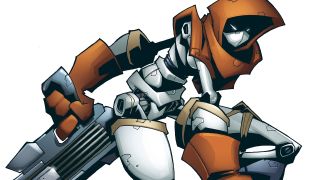Note: This is an updated version of an article we ran a few years back, but its content, like the game it discusses, is as relevant now as it ever was. With the news that Dambuster Studios parent company Koch Media has finally brought the TimeSplitters rights back to the series' remaining developers, it seems entirely worth digging in to why the return of TimeSplitters (and potentially its second entry in particular) is such a big deal, and a better fit in 2018 than it was even at the time of its original release.
**Article continues below**
I’ve never understood why anyone was surprised when Perfect Dark Zero turned out to be a bit crap. In fact I never understood why anyone ever really expected it to be any kind of a genuine follow-up to Rare’s classic FPS work on the Nintendo 64 at all. Anyone still waiting for that in 2005 had entirely missed the boat.
You see the thing is, the Rare that made Perfect Dark Zero was not the Rare that made Goldeneye. A number of that studio had left to form Free Radical Design long before the Xbox 360 came around. And at Free Radical, they had already created the successor to Rare’s biggest N64 successes years before anyone ever bandied about the phrase “HD remake”. Or in fact, the phrase “HD”.
You want the real sequel to Goldeneye and Perfect Dark? Do you want, in fact, the game that quietly paved the way for everything shooters have become in 2018, pre-empting all the big ideas and trends but getting very little of the credit? If that's what you want, then you come to TimeSplitters 2. That’s where you come. Let me tell you all about it.
Golden memories
So it’s 2002. I’m talking to a friend, and he’s very excited about something. “Have you played TimeSplitters 2? It’s from the people who made Goldeneye and it’s full of film references and it’s brilliant. You’ve got to come round and check it out” So I did. And we played it all afternoon. And then I immediately bought a copy of my own.
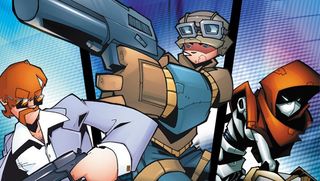
I’d been dubious at first. Not distrustful, you understand. But to an FPS-loving, film-geek Nintendo fan like myself, TimeSplitters 2 just sounded too perfect. Like a game woven out of my very soul. And besides, Rare had nothing to do with it. I’d checked. My friend was getting confused and over-enthusiastic about a new game, that was all.
But he wasn’t. After two minutes with TimeSplitters 2’s opening level, everything made sense. This was Goldeneye 2, from the Goldeneye team, but way better than an actual sequel to Goldeneye could ever have been. TS2 you see, was designed by David Doak, who also designed Goldeneye and Perfect Dark. The soundtrack was composed by Graeme Norgate, who also composed the soundtracks to Goldeneye, Perfect Dark, Killer Instinct, Blast Corps and Jet Force Gemini. It had the same clever and imaginative level design of the Rare FPS of old, and the same fast, twitch-friendly action. Hell, the pause screen was even accessed by looking at a physical, in-game gadget, just like pulling up Goldeneye’s magical spy watch. In fact even the damn health and shield system looked almost exactly the same on-screen.

TimeSplitters 2 proudly, cheekily, almost ostentatiously display its true nature and origins right from the first playable screen. You find yourself outside a huge, militarised dam on the edge of a vast Siberian snow field. A small encampment of out-buildings lays just ahead of you, patrolled by a currently unaware set of guards. In front of you lies a silenced pistol and a sniper rifle. Your objective is to infiltrate the complex before making your way to your final goal at the top of the dam. Sound familiar? Of course it does. That one level is the best combined tribute to Goldeneye you could want. And it certainly isn't just about the setting.
You see where the first TimeSplitters was a fairly simple smash-and-grab time attack shooter, TS2 is the real deal. It's a sharp, brilliantly paced FPS with personal player input right at the forefront of the design. You can play it like Bond or you can play it like Rambo, and that first level is a beautifully pitched introduction to its design philosophy. You could, if you want to, go loud straight away, mulching through the opening enemy camp in a whirlwind blaze of glory, triggering alarms and shredding all comers. But it's also entirely possible to Metal Gear through it, using trial and error to master a carefully-planned cover route, employing silent and precisely-timed one-shot takedowns to butcher the entire squad and complete four objectives (three optional) without ever being detected.
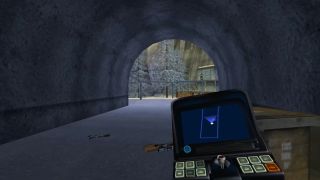
Nothing is handed to you on a plate of course. In fact it took me a good hour of experimentation to perfect my run of that opening area, taking into account the tight timings of patrol patterns, the correct order of kills, situational weapon choice, and the subtleties of the cover, security camera effectiveness and safe shooting angles. Not to mention dealing with that barely-visible sniper in the tower about half a mile away, across the other side of the map.
The first few metres of that level are a meta-game in themselves. And inspired by my victory there, I took my newfound tactical skills into the level proper, where I discovered (with a lot more digging) that it is entirely possible to get through around two-thirds of the stage with a 100% bodycount without being spotted once. That my friends, is some serious game design right there. Doubly serious when you consider that once you work out how to do it, you’ll discover that this initially implausible stealth run requires almost every drop of ammo that is actually available throughout the level. Clever bastards, Free Radical. Clever bastards indeed.
But the best was yet to come. And there was going to be a lot of it.
From that superbly crafted campaign opening, TimeSplitters 2 takes its cleverness everywhere and everywhen it can possibly dream up. With the smartly-designed plot device of a Quantum-Leap-style time-jumping space marine possessing the bodies of various individuals throughout history (in order to collect lost artefacts needed to repel an oncoming alien invasion), TS2 can be unconstrained by level-to-level consistency without ever losing overall narrative cohesion. You can be anyone, in any place, and any time, but the overarching storyline always remained solid. And oh boy, does TimeSplitters 2 revel in that freedom.
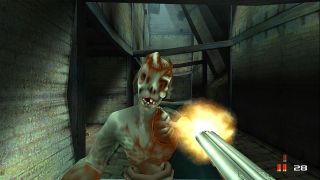
TimeSplitters 2 makes every one of its levels a unique narrative vignette, a self-contained, fantastically-realised world and story with a mood and play-style all of its own. In many ways, it is the video game equivalent of a good anthology TV series, a wise-cracking, wittier, media-savvy, cartoon Outer Limits, whose every new reveal is an utter joy.
You know that never-repeated excitement that you get at the start of a brand new game, as you first get to know its mechanics, and start to breathe in its atmosphere, and begin to understand its world? TimeSplitters 2 delivers that anew at the beginning of every single level. Every time, place, theme and cinematic touchstone is completely well enough realised to carry a whole game on its own, so while it's always sad to leave one behind - always wanting just a little bit more - any completion regret is instantly washed away by the rush of the next level’s intriguing, often downright funny introductory cut-scene. And speaking of movie influences…
In-game cinematic
Lots of games do film references. Hell, a lot of them try to be films. But while a cinematic nod all too often simply takes the form of a lazily quoted movie line or referenced character name (or just straight-up lifting something from Aliens), TimeSplitters 2 lives and breathed that stuff in a wonderfully warm, holistically implemented way, observing and understanding its influences in a far more purposeful way.

After the initial Goldeneye flourish, it's straight on to a gorgeously atmospheric gangster level set in 1932, taking in prohibition enforcement, witness protection, drive-by shootings and an all-out assault on a gangland nightclub, all set to a smooth, laid-back, but infectiously upbeat jazzy soundtrack. Then, after a rather affectingly creepy intro, comes 1890s Notre Dame, a Hammer-meets-Tim-Burton gothic horror filled with zombies, catacombs, cultists, romantic hunchbacks, and lightning storms aplenty.
Fancy something a bit spacier? Well how about the bright, bold, blue-skied sci-fi of Planet X, which plays out like a mega-budget ‘50s b-movie, with a pulse-pounding soundtrack akin to The Prodigy gone retro-futurist. And how about mixing up the pace with a labyrinthine, puzzle-driven, Aztec jungle in 1920, evoking the very vibe that the upcoming Strange Brigade has built a whole game around? Or combining the full might of Austin Powers, Jason King and ‘60s Bond in the Atom Smasher level? And there’s more. So, so much more. I haven’t even got onto the suffocating neon-noir atmosphere and low-key intricacy of the stunning 2019 Neo Tokyo Blade Runner level. I love you, stunning 2019 Neo Tokyo Blade Runner level.

And you know what else I haven’t even got onto? Loads, that’s what. TimeSplitters 2 has absolutely some of the finest split-screen multiplayer in all of console FPS. But then, as thr successor to Goldeneye, it was bound to. In the same fashion that TS2’s campaign builds upon and develops the design conceits of Goldeneye’s single-player, so too does it develop its PvP multiplayer. Remember the old trick of picking Oddjob on the N64, because his diminutive stature caused your friends to mis-judge their headshots? TS2 multiplayer goes ballistic with that concept. In fact, in 2002, it paved the way for the modern Hero Shooter movement as we know it.
There are normal-sized characters. There are massive characters. There are tiny monkeys. There are hulking great robots who are fireproof thanks to their metal bodies. You want an eclectic set of multiplayer character options? Well TimeSplitters 2 has a cast of 70, split into broad classes. And you can play them over 16 different, wildly imaginative modes, covering every team-based or elimination mode you can think of and plenty you can’t. And you know what’s even better? They're unlocked by playing all the other modes...
And there's more...
There's a huge single-player challenge component too. Mashing together all the wildly imaginative characters and scenarios from elsewhere in the game, Arcade League provides a terrifying number (45, to be precise) of delirious, cheese-dream objectives based around TS2’s core multiplayer modes, all with multiple medal awards for improved scores and completion times, and all unlocking new, meaningful content across the board. No half-arsed production art or simple Trophies and Achievements here. This is stuff you actually want and can actually use.

Maybe you’ll find yourself cast as an embattled Chinese chef struggling to put down his rampaging stock of calamari by way of a flamethrower rampage. Or perhaps you’ll be a mob boss, wandering around a hospital, high on anaesthetic after a hair-transplant operation, hallucinating an attack by giant ducks. Or maybe you’ll find yourself in a dinosaur-killing Turok parody, whose entire back-story justification is just one long set-up for a cerebral bore joke.
And there's the officially-monikered Challenge mode too, providing another 21 objective-based minigames built around the main campaign’s core mechanics and weapons. There are stealth challenges. There are headshot challenges. There are “smash all the windows as fast as you can using only a brick” challenges. There are tower defence levels involving the Siberian dam and a barrage of exploding monkeys. There are speed-run shooting galleries. There are collect ‘em ups built entirely around the concept of a monkey’s lost banana hoard (and yes, that is another sly to the studio's Rare lineage, 100%).
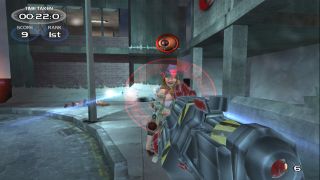
TimeSplitters 2 was and still is utterly ridiculous in terms of both the amount of content it provides and the sheer wealth of ideas and imagination it packs into that content. In fact, in hindsight, it was the clear forerunner to a huge number of the themes and conceits that would define gaming more than a generation after its launch.
Class-based character shooters. Horde modes. Speed-running. Leaderboard challenges. Campaign co-op. Persistent 'games-as-service'. Spin-off gameplay remixes as additional play modes. Skins and character customisation as long-term loot drive. User-generated content... Whatever evolutions you can think of as having defined action games and their DLC over he last 15 years, TimeSplitters 2 did it all. And it did it first, and it did it bigger, and it did it weirder, and it did it in much greater volume. One one disc, with no additional charges.

Sorry, did I mention user-generated content as well? Yeah, you can build your own multiplayer and campaign levels in TimeSplitters 2. The editor never got the chance to shine that it deserved, due to consoles' comparative lack of online connectivity when it was released, but it was absolutely the frerunner to Doom 2016's brilliant SnapMap suite. Combined with the rest of the game’s way-ahead-of-its-time content, TimeSplitters 2's map editor makes the game unbelievably appropriate for a modern day re-release. With a bit of tidying up and a few control concessions for 2018, it would feel as modern today as it ever has, and leave more than a few games still looking to play catch-up.
And now, finally, Koch Media has the rights. Which means that TimeSplitters is back home, with Dambuster Games, the studio descended from Free Radical itself. And wheels are spinning up for a series restart. TimeSplitters 4 was famous well into pre-production before financial problems forced an end to the series and its developer during the last generation, but whatever the future holds for TimeSplitters, at least an HD collection is surely now a lock-in. In fact, some of it doubtless already exists, given that Dambuster hid a couple of playable TS2 levels inside its 2016 release Homefront: The Revolution.

And more than any other re-release, it is warranted and deserved. TimeSplitters 2 HD alone will be more than worth the price of admission, and provide a startling insight into just how forward-thinking an offline, 2002 shooter could be.
And in today's post-Overwatch, post-SnapMap, post-Fortnite, post-everything landscape - where fast, colourful, expressive shooters have beaten out the last-gen blight of staid, sober, relentlessly brown military FPS - we finally have an video games environment which has caught up TimeSplitters 2's uncannily prescient ways. It pre-empted 15 years of action game design all the way back on the GameCube and PS2, and it vibrant, witty approach to fun is thankfully well and truly back in style. As such, TimeSplitters 2 - and its series - should thrive today like never before.
